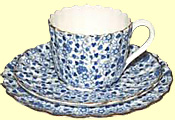Ginna's Quick Guide to Ceramics
Earthenware : Stoneware : Porcelain : Bone China
Bone China
Bone china is a type of porcelain that is composed of bone ash, feldspar and kaolin. Developed
by English potter Josiah Spode in 1797, bone china is known for its hardness, high level of whiteness and translucency.(We
do not fire bone china.) 
The component responsible for bone china's famous whiteness and translucency is calcined bone ash, which makes up as much as 50% of bone china's composition.
Bone china is produced much as traditional porcelain is, except with more care, because bone china has lower values of plasticity and a narrower vitrification rate. "Plasticity" is the malleability of the clay and "vitrification" is the process of melting that bone china goes through as it is fired.
Bone china is composed of about 25% china clay, 25% Cornish stone, and 50% bone ash. The bone ash that is used in bone china is made from cattle bones that have a lower iron content. From these special cattle bones, bone flour is produced and then calcined at 800-1000 degrees Celsius. The final product, the ash, is then ground and dried.
To counteract the low plasticity, kaolin is added to the bone china mixture. Kaolin is a soft clay mineral that is typically an essential ingredient in the production of porcelain.
The production of bone china is considered to be labor-intensive and not only that, the components of bone china are also expensive. These factors, including the quality and maker, are the reason for bone china's luxury status and high pricing. Adapted from Wikipedia